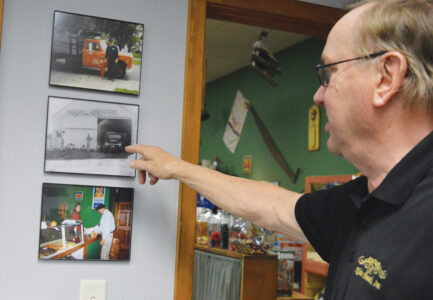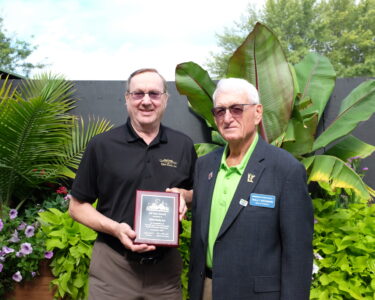Marshall solar farm ‘performing well’
Energy providers hold dedication for Marshall Solar Plus project

Officials including Missouri River Energy Services President and CEO Matt Schull, US Solar president Reed Richerson, and Marshall Mayor Bob Byrnes took part in a ribbon-cutting ceremony for the new solar farm in Marshall. The 78-acre solar project on North Seventh Street includes five megawatts of battery storage for electricity.
MARSHALL — The new solar farm on the north edge of Marshall has been up and running for a few months, and energy providers said things have been going smoothly so far.
“It’s performing very well. We work hand-in-hand with Marshall Municipal Utilities to operate it,” said Matt Schull, president and CEO of Missouri River Energy Services (MRES). MRES, which supplies electricity to Marshall Municipal Utilities, also operates the Marshall Solar Plus project, a 10-megawatt solar farm with battery storage that went into operation in December.
Electricity generated by Marshall Solar Plus is used in the Marshall community.
Representatives of MMU, MRES, the Western Minnesota Municipal Power Agency (WWMPA) and US Solar, the contractor that built the project, held a dedication ceremony in Marshall on Tuesday. Rainy weather moved the dedication and ribbon-cutting for Marshall Solar Plus indoors, to The Upper Room.
“I apologize the weather did not cooperate with us, but it does give us an opportunity to talk about the batteries associated with the solar panels,” Schull told the gathering.
The Marshall Solar Plus project is a 10-megawatt solar farm, with an additional five megawatts of battery storage for when the sun isn’t shining. The 78-acre solar farm was built near North Seventh Street in Marshall last year.
“That is a larger project than probably most people in the community realize,” said Marshall Mayor Bob Byrnes. “It is a $32 million investment, with 21,000 solar panels. And probably what’s really important to this project is the battery backup.”
“The five-megawatt, four-hour battery storage system . . . was installed to enhance the project’s reliability,” Schull said. “The battery system has controls that allow energy to be stored and then dispatched to the electric grid when needed, or when solar energy is not being produced.”
US Solar President Reed Richerson said the battery storage system’s capacity was roughly equivalent to about 400 long-range Tesla Model 3 electric cars. “So, a ton of power capacity to be able to charge, and then discharge at those opportune times,” he said.
Schull said the solar farm is expected to generate about 23,000 megawatt hours of energy per year. That’s enough to power more than 2,000 homes, he said.
Richerson said another feature of the Marshall solar project was that native pollinator-friendly plants would be established on the land the solar panels stand on. “It’s kind of like 60 acres of CRP land,” he said. “I think that’s a really great thing for the community, and we’re happy to be part of it.”
Byrnes said the completed solar project was the result of partnerships between the city of Marshall, MMU, MRES and other groups. It was also a partnership that had a big impact on Marshall.
“Reliable electricity is essential for the quality industries and businesses that we have here,” Byrnes said. “That’s really what our municipal utilities are able to deliver.”
Missouri River Energy Services (MRES) has 61 member communities across Minnesota, Iowa and the Dakotas. Each community operates a local electric system. Marshall Municipal Utilities is a member of MRES.
“We are fortunate and proud to say that over 40% of our energy comes from renewable resources,” Schull said. “On top of that, we’ve been actively adding renewable energy and carbon-free resources to our power supply for the better part of the last 20 years.”
Schull said MRES was actively building another solar facility in Brookings, South Dakota, although that project will not include battery storage. MRES’ energy portfolio also includes hydroelectric and wind power, and a contract for nuclear power form a facility in Wisconsin, he said.
“The solar project represents a forward-looking investment in renewable energy, and helps us work toward our long-range strategic of creating a clean, resilient energy future,” said MRES board chair Vernell Roberts.


